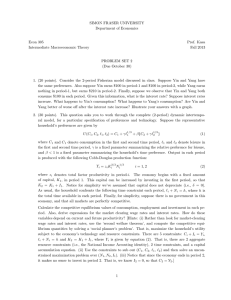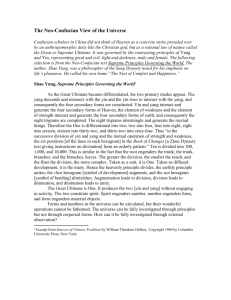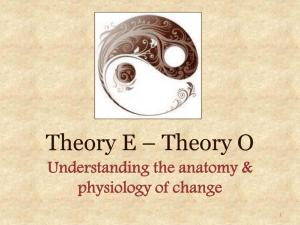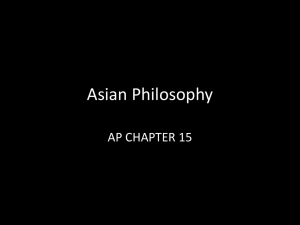SIMON FRASER UNIVERSITY Department of Economics Econ 305 Prof. Kasa
advertisement
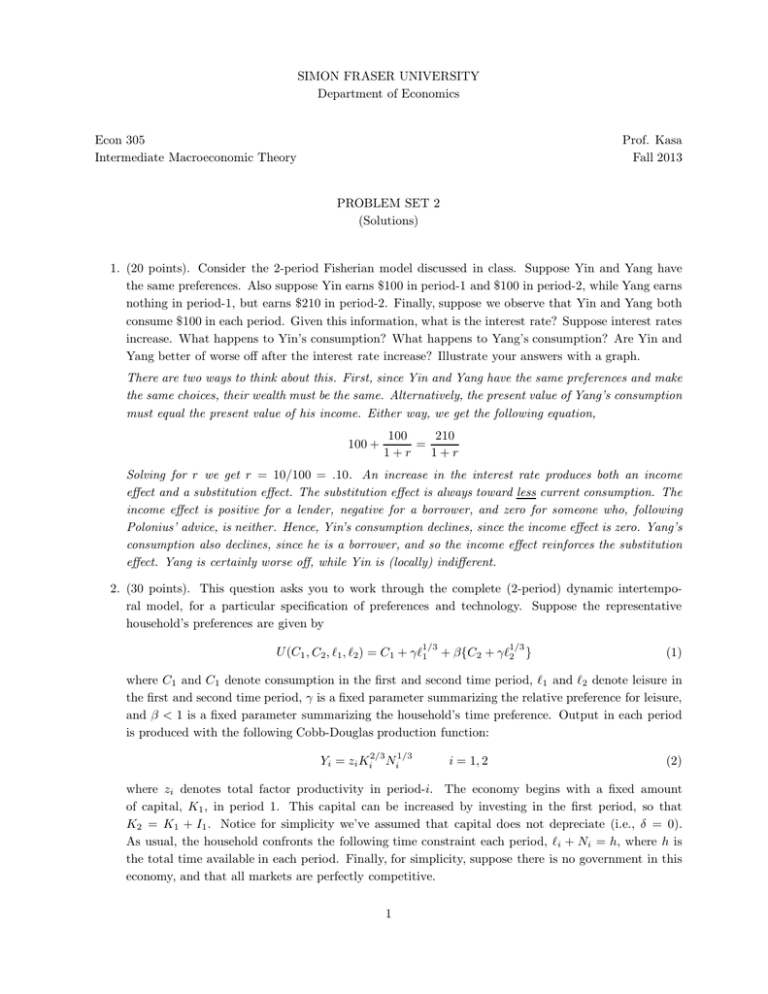
SIMON FRASER UNIVERSITY
Department of Economics
Econ 305
Intermediate Macroeconomic Theory
Prof. Kasa
Fall 2013
PROBLEM SET 2
(Solutions)
1. (20 points). Consider the 2-period Fisherian model discussed in class. Suppose Yin and Yang have
the same preferences. Also suppose Yin earns $100 in period-1 and $100 in period-2, while Yang earns
nothing in period-1, but earns $210 in period-2. Finally, suppose we observe that Yin and Yang both
consume $100 in each period. Given this information, what is the interest rate? Suppose interest rates
increase. What happens to Yin’s consumption? What happens to Yang’s consumption? Are Yin and
Yang better of worse off after the interest rate increase? Illustrate your answers with a graph.
There are two ways to think about this. First, since Yin and Yang have the same preferences and make
the same choices, their wealth must be the same. Alternatively, the present value of Yang’s consumption
must equal the present value of his income. Either way, we get the following equation,
100 +
210
100
=
1+r
1+r
Solving for r we get r = 10/100 = .10. An increase in the interest rate produces both an income
effect and a substitution effect. The substitution effect is always toward less current consumption. The
income effect is positive for a lender, negative for a borrower, and zero for someone who, following
Polonius’ advice, is neither. Hence, Yin’s consumption declines, since the income effect is zero. Yang’s
consumption also declines, since he is a borrower, and so the income effect reinforces the substitution
effect. Yang is certainly worse off, while Yin is (locally) indifferent.
2. (30 points). This question asks you to work through the complete (2-period) dynamic intertemporal model, for a particular specification of preferences and technology. Suppose the representative
household’s preferences are given by
1/3
U (C1 , C2, `1, `2) = C1 + γ`1
1/3
+ β{C2 + γ`2 }
(1)
where C1 and C1 denote consumption in the first and second time period, `1 and `2 denote leisure in
the first and second time period, γ is a fixed parameter summarizing the relative preference for leisure,
and β < 1 is a fixed parameter summarizing the household’s time preference. Output in each period
is produced with the following Cobb-Douglas production function:
2/3
Yi = zi Ki
1/3
Ni
i = 1, 2
(2)
where zi denotes total factor productivity in period-i. The economy begins with a fixed amount
of capital, K1 , in period 1. This capital can be increased by investing in the first period, so that
K2 = K1 + I1 . Notice for simplicity we’ve assumed that capital does not depreciate (i.e., δ = 0).
As usual, the household confronts the following time constraint each period, `i + Ni = h, where h is
the total time available in each period. Finally, for simplicity, suppose there is no government in this
economy, and that all markets are perfectly competitive.
1
Calculate the competitive equilibrium values of consumption, employment and investment in each period. Also, derive expressions for the market clearing wage rates and interest rates. How do these
variables depend on current and future productivity? [Hints: (i) Rather than look for market-clearing
wage rates and interest rates, use the ‘second welfare theorem’, and compute the competitive equilibrium quantities by solving a ‘social planner’s problem’. That is, maximize the household’s utility
subject to the economy’s technology and resource constraints. There are 5 constraints: Ci + Ii = Yi,
`i + Ni = h and K2 = K1 + I1, where Yi is given by equation (2). That is, there are 2 aggregate
resource constraints (i.e., the National Income Accouting identity), 2 time constraints, and a capital
accumulation equation. (ii) Use the constraints to sub out (C1 , C2, `1 , `2 ) and then solve an unconstrained maximization problem over (N1 , N2 , I1). (iii) Notice that since the economy ends in period 2,
it makes no sense to invest in period 2. That is, we know I2 = 0, so that C2 = Y2 .]
Using the constraints to sub out C1 , C2, `1 and `2 gives us the following unconstrained optimization
problem:
h
i
2/3 1/3
1/3
max z1 K1 N1 − I1 + γ(h − N1 )1/3 + β{z2 (K1 + I1 )2/3N2 + γ(h − N2 )1/3}
N1 ,N2 ,I1
The first-order conditions are:
N1 :
N2 :
I1 :
1
1
2/3 −2/3
− γ(h − N1 )−2/3
z1K1 N1
3
3
1
1
2/3 −2/3
β{ z2 (K1 + I1 ) N2
− γ(h − N2 )−2/3}
3
3
2
1/3
− 1 + β z2 (K1 + I1 )−1/3N2
3
= 0
= 0
= 0
`
The first equation is just the usual U
Uc = w condition for the first period, using the particular functional
forms here, and using the fact that in a competitive equilibrium, w = M P L. The second equation
is the same thing for the second period. The third equation is sometimes called an ‘investment Euler
equation’. It says that UC1 = (1+r)UC2 , where in a competitive equilibrium (1+r) = M P K. That is, an
optimal intertemporal consumption/saving plan equates the marginal utility of today’s consumption to
the (discounted) marginal utility of tomorrow’s consumption times the rate of return from investment.
The first equation can easily be solved for N1 to get:
N1 =
K1 +
K1
3/2 h
γ
z1
Note that γ ↑ ⇒ N1 ↓ and z1 ↑ ⇒ N1 ↑, as you would expect. Substituting this expression into
2/3 −2/3
the equilibrium condition, w = M P L = 13 z1K1 N1
, and then simplifying, gives us the following
expression for the market-clearing wage rate in period 1,
1
w1 =
3
3/2
K1z1
+ γ 3/2
h
!2/3
Note that first period wages rise when z1 increases and when γ increases. In the first case, the labor
demand curve shifts right. In the second case, the labor supply curve shifts left.
Solving for N2 and I1 is a bit more complicated because the two decisions are interrelated. That is, how
much you invest in the first period depends on the marginal product of capital, which depends on how
much you plan to work next period, since that influences the return from investment. Hence, we have
2
to solve two simultaneous equations. Still, it’s not too bad. First, note that the first-order condition
for I1 implies:
1/3
K1 + I1
2βz2
(3)
=
N2
3
while the first-order condition for N2 implies:
z2
K1 + I1
N2
2/3
= γ(h − N2 )−2/3
(4)
2
2
Substituting equation (3) into equation (4) then gives us, z2 2βz
= γ(h − N2 )−2/3. Solving for N2
3
gives us the following expression for the equilibrium period 2 employment:
N2 = h −
−9/2
γ 3/2 z2
2β
3
−3
Note once again that employment increases with z, but decreases with γ. Finally, note that equation
3
2
(3) implies K1 + I1 = N2 2βz
. Substituting the equilibrium N2 into this gives us the equilibrium
3
first period investment:
3
2βz2
γ 3/2
I1 =
h − 3/2 − K1
3
z
2
Note that first period investment increases when second period productivity increases. Less obviously,
note that investment decreases when γ increases. A higher γ depresses equilibrium employment, which
then depresses the marginal product of capital. Finally, to get the market-clearing interest rate, note
1/3
that 1 + r = M P K = 12 z2 (K1 + I1 )−1/3N2 . However, notice from equation (3) that this just implies
1
(1 + r) = β !.
3
